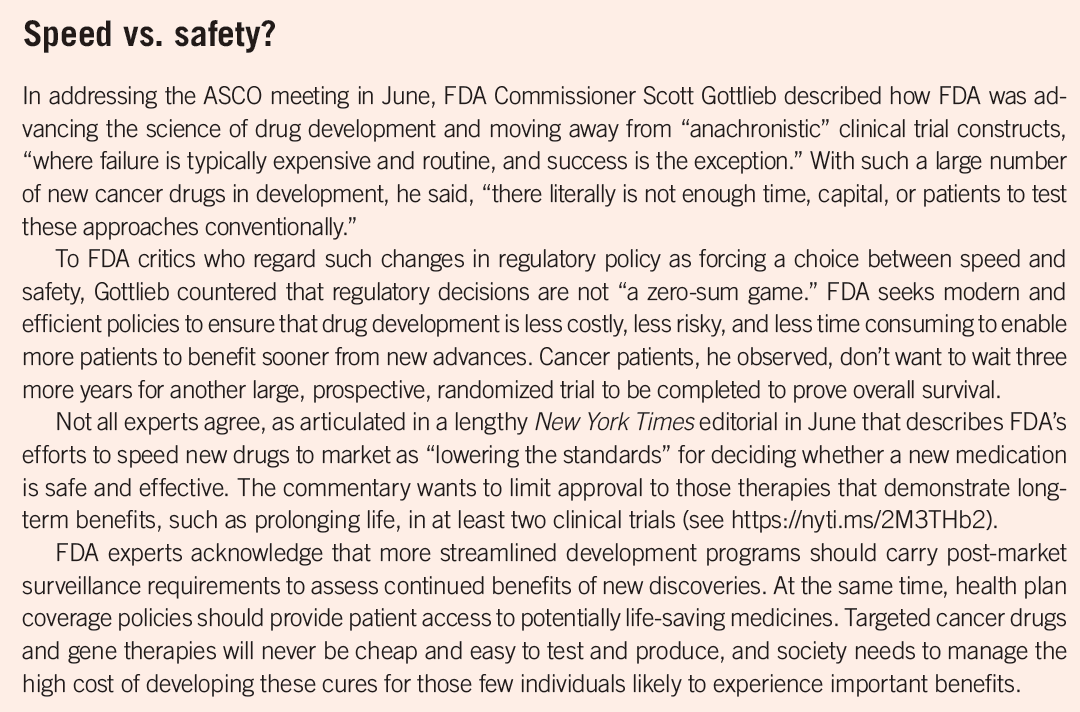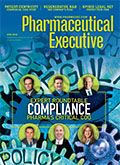Regulatory Innovation Generates Breakthroughs
Pharmaceutical Executive
Streamlined clinical research, more guidance speed new cures to patients.
FDA is overhauling its new drug review process and launching new pilots and strategies to modernize clinical research and data analysis in order to move more cutting-edge therapies through the regulatory process to patients. Reports of positive outcomes and extended benefits from targeted cancer treatments at the June
Jill Wechsler

meeting of the American Society of Clinical Oncology (ASCO) generated great enthusiasm for genetic analysis and immune marker testing to better match treatment to disease markers in the growing field of precision medicine. New incentives, moreover, promise to encourage the development of much-needed antibiotics, and gene and cellular therapies are emerging from initiatives to streamline testing and oversight of innovative biologics.
While biopharma companies and the research community applaud these efforts, skeptics continue to raise concerns that long-term safety risks, unsure efficacy, and high price tags may limit benefits and keep important treatments out of reach for many individuals (see sidebar at bottom). FDA Commissioner Scott Gottlieb maintains that less costly clinical research and faster approvals should boost competition in pharmaceutical markets and bring down the cost of many important drugs in the process.
More efficient studies
At the ASCO meeting, Gottlieb outlined FDA efforts to keep pace with medical innovation through updates in clinical trial operations, regulatory policies, and manufacturing standards to create a more efficient, less costly and more innovative review process. For example, FDA is testing a program that permits reviewers to assess a sponsor’s clinical trial data before the application is filed to ensure that submissions contain all relevant information needed for a timely review. Another strategy involves creating a common review template for both FDA staffers and applicants to record comments and answer questions, avoiding multiple parallel review documents.
There’s also great excitement over the emergence of new cellular and gene therapies, with three innovative products on the market and analysts reporting more than 500 in early development. FDA’s Center for Biologics Evaluation and Research (CBER) has established policies and procedures for overseeing treatments that qualify for the Regenerative Medicine Advanced Therapy (RMAT) designation, and CBER plans to issue further guidance documents to clarify manufacturing and testing policies, starting with hemophilia treatments. Because these therapies target devastating diseases, FDA expects to approve promising products based on surrogate measures, with post-market studies using registries and real-world patient evidence to document continued benefit or safety issues. CBER also seeks to clarify ways to deal with the complex production and scale-up issues for these biotech therapies that often delay product approval and marketing.
While scientists are pursuing extensive research to treat cancer and genetic diseases, efforts to combat the spread of drug-resistant infections have been limited, as R&D difficulties and financial impediments have discouraged development of innovative antibiotics and antimicrobials. A new research strategy may help, as seen in recent FDA guidance on how manufacturers may utilize streamlined research methods and accelerated approval policies for therapies that qualify for the Limited Population Pathway for Antibacterial and Antifungal Drugs (LPAD).
To spur industry investment in this field, Gottlieb recently proposed a licensing model with a “pull incentive” to ensure manufacturer reimbursement for new infectious disease treatments. The idea is that hospitals and clinics would pay a fixed licensing fee to access a certain volume of doses of the new medicine, creating predictable revenue for the developer, while discouraging excessive use of the new treatment that often leads to resistance.
Getting personal
These R&D initiatives aim to further tap patient expertise on evaluating burden of disease and treatment preferences in designing research strategies. FDA has moved over the last decade to achieve a more systematic approach for incorporating patients’ experiences into the clinical testing process and continues to seek better ways for measuring and collecting patient experience data, such as registries to identify in advance those patients who meet enrollment criteria. Initiatives to advance precision oncology treatments involve assessing patient-reported outcomes (PROs) in cancer trials and FDA use of PRO data in regulatory review.
The agency recently published the first of several guidances that aim to further utilize patients’ perspectives in drug development. This draft advisory recommends methods for collecting patient data in clinical trials, and additional guidances will provide more specifics on using interviews and survey information, on identifying issues most important to patients, and in selecting patient-focused study endpoints. The overall goal is to map out sound methodology for collecting patient input so it provides valid data that can inform regulatory decisions.
Sidebar: Advancing the science of drug development; click to enlarge

Maintaining a speedy, efficient new drug review process is vital to FDA’s success in encouraging innovation and speeding new breakthrough therapies to patients. To be able to assess the growing volume of promising new drugs and biologics in accelerated and compressed timeframes, the Center for Drug Evaluation and Research (CDER) is overhauling its Office of New Drugs (OND).
Janet Woodcock, CDER director, has led the reorganization initiative this past year, with an eye on encouraging team-based reviews and systems to make the oversight process more efficient and consistent. A “flatter” OND will have nine instead of five drug review offices, with up to 30 specific review divisions. CDER staff must deal with a “staggering pace of work,” Woodcock said, and that involves attention to detail and keeping up with emerging scientific advances in genomic medicine, targeted therapy, digital health, drug-device combinations, and more global drug development programs.
Jill Wechsler is Pharmaceutical Executive’s Washington Correspondent. She can be reached at jillwechsler7@gmail.com

Addressing Disparities in Psoriasis Trials: Takeda's Strategies for Inclusivity in Clinical Research
April 14th 2025LaShell Robinson, Head of Global Feasibility and Trial Equity at Takeda, speaks about the company's strategies to engage patients in underrepresented populations in its phase III psoriasis trials.
Bristol Myers Squibb’s Cobenfy Falls Short in Phase III Trial as Add On Therapy for Schizophrenia
April 23rd 2025In the Phase III ARISE trial, Cobenfy administered as an adjunctive treatment to atypical antipsychotics for patients with inadequately controlled schizophrenia did not achieve statistically significant improvements.